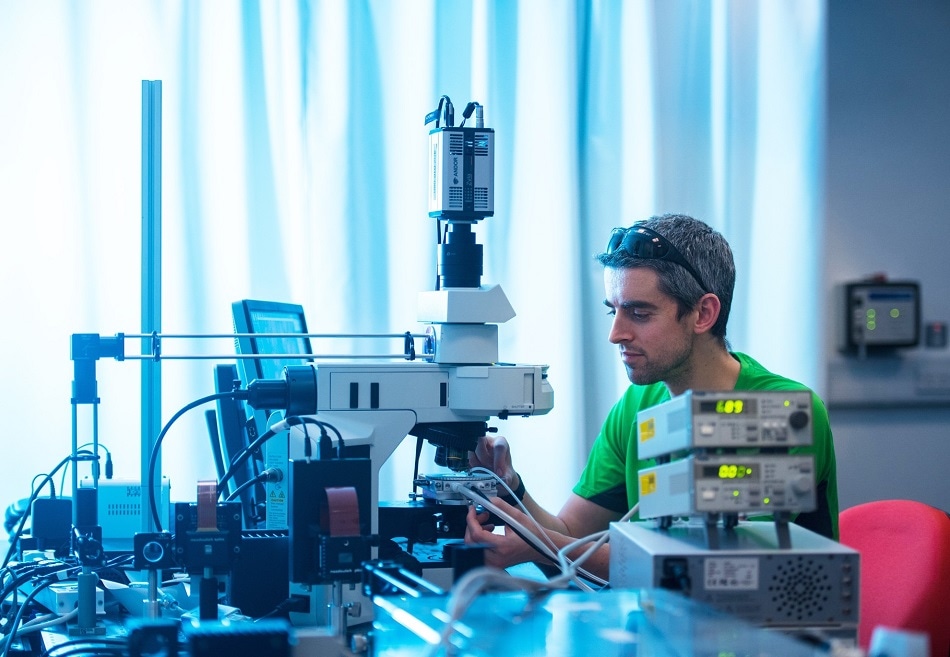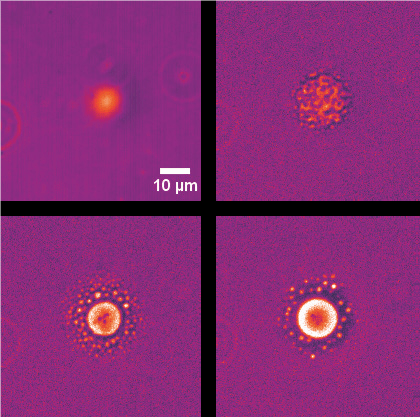
A team of scientists set out to understand how and why lasers trigger crystallisation and how changes made to the properties of the laser could influence which crystal form would be generated. Researchers working with Prof. Klaas Wynne of The School of Chemistry at the University of Glasgow have used the Linkam THMS600 temperature-controlled stage to explore phase transitions in mixed liquid systems and laser-induced nucleation.
The central hypothesis under investigation was that there were hidden ‘critical points’ (either in a single liquid, or when two immiscible liquids mix or separate in response to temperature) where dramatic fluctuations in relative concentration occur, and that at these ‘critical points’ laser light was able to enhance this effect and lead to laser-induced nucleation.
The team constructed a phase-contrast microscope and laser set-up to conduct some preliminary experiments. These first laser-induced phase separation (LIPS) experiments were carried out on mixtures of nitrobenzene and decane at mole fractions and temperatures where the mixture was stable. When the laser was focused in the sample, a bright spot was visible under the microscope. This indicates that LIPS takes place and that the fraction that is separated out has a higher refractive index and must therefore be nitrobenzene rich. This was confirmed with the dye methylene blue and fluorescent detection.

LIPS and Nucleation (LIPSaN) experiments in nitrobenzene–decane at T = 23.9°C with a 120-mW 785-nm focussed laser, on for 30 s.
Subsequent temperature-controlled experiments using the THMS600 allowed the group to clearly show that the LIPS effect increases strongly on cooling as the binodal is approached and proximity of a liquid-liquid critical point can be used by a laser-tweezing potential to induce concentration gradients.
Finally, the laser-induced nucleation was shown in experiments where, when the laser was switched on, the LIPS effect draws nitrobenzene into the focus, reducing the concentration on the surrounding volume. When the laser is switched off, the temperature rapidly drops, the depleted volume falls below the binodal and this triggers the nucleation of phase-separated droplets.
The group concluded that phase manipulation and nucleation can be reliably induced with a straightforward laser set-up. The results look set to have profound implications for the understanding of these important phenomena. The LIPS experiments and related theory not only explain the physics behind non-photochemical laser-induced nucleation, but also suggest potential new ways of manipulating matter.
The Linkam stage integrated so well with our microscope – we have long-field objectives and the stage fitted perfectly into it. The temperature control was extremely good. We want to get really close to this critical point and so having control to 0.1 Kelvin is essential. The Linkam stage was so fast as well, we saw no discernable lag as we approached the target temperature – and the temperature that the stage indicated was the actual temperature, something that we haven’t always seen with other systems.
Finlay Walton, PhD Student, School of Chemistry, University of Glasgow
Read a longer case study on this research here: https://bit.ly/LInkam-GlasgowArticle
This work is published in Nature Chemistry, and can be viewed here: https://www.nature.com/articles/s41557-018-0009-8
For more details about the Linkam THMS600 stage, visit: www.linkam.co.uk/thms600